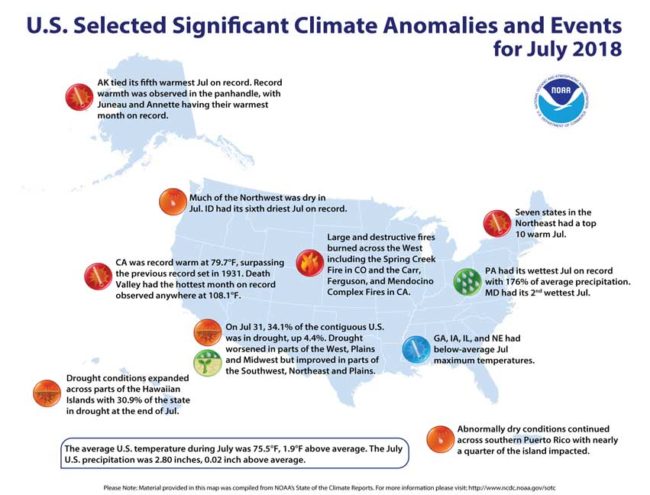 Each month the NOAA National Centers for Environmental Information (NCEI) issues a climate assessment for the preceding month. July’s has now been issued. A highlight is that California had its hottest July and hottest month on record at 79.7°F, surpassing the previous record set in 1931.
Each month the NOAA National Centers for Environmental Information (NCEI) issues a climate assessment for the preceding month. July’s has now been issued. A highlight is that California had its hottest July and hottest month on record at 79.7°F, surpassing the previous record set in 1931.
This is not a PR exercise on behalf of the Climate, this monthly summary from NOAA’s National Centers for Environmental Information is part of the suite of climate services NOAA provides to government, business, academia and the public to support informed decision-making.
July 2018 Assessment Highlights
- For the entire US, the contiguous U.S. temperature was 75.5°F, 1.9°F above the 20th century average. It’s the 11th hottest ever recorded.
- For California, it was the hottest July and hottest month ever recorded.
- If you look a bit further back and expand the scope to three months, then May to July was ranked as the warmest such period on record with a national temperature of 70.9°F, 3.4°F above average. This surpassed the previous record of 70.6°F in 1934.
July 2018 Significant Climate Anomalies
Within their report they have also published the following illustration of the unusual …
Ideal Wildfire Conditions
Rather obviously hottest and driest has had some rather dire consequences for the state. It has created ideal wildfire conditions. Numerous large and destructive fires burned across the region with many continuing to burn into August. These included, but were not limited to:
- The Spring Creek Fire in Colorado burned over 108,000 acres and destroyed 251 homes. This was the third largest wildfire on record for Colorado.
- The Carr Fire in California burned over 164,000 acres, destroyed more than 1,000 residences and was responsible for at least seven fatalities. This marks the sixth most destructive fire in terms of property loss on record for California.
- The Ferguson Fire in California burned over 94,300 acres, was responsible for at least two fatalities and forced the closure of parts of Yosemite National Park.
- The Mendocino Complex Fire in California burned over 283,800 acres and marked the largest wildfire on record for the state, surpassing the Thomas Fire that burned 281,000 acres in late 2017.
Beyond that specific Report what else do we know about July?
NCEI also issue a regular drought report. The latest which was published on 7th August reports the following …
moderate to exceptional drought covers 30.2% of the United States, an increase from last week’s 29.0%. Extreme and exceptional drought—the worst categories—also expanded to cover 7.5% of the nation, up from 7.1% last week.
…Abnormal dryness and drought are currently affecting over 125 million people across the United States—about 40.3% of the country’s population.
The Washington Post reported that Death Valley set a new record …
Last July, California’s Death Valley endured the hottest month ever measured on the planet. This July ended up even hotter.
Over both day and night, the temperature at Death Valley averaged 108.1 degrees, ahead of the mark set a year ago by about a half-degree. That previous mark had broken a record that stood for 100 years.
This year’s exceptional temperature extreme at one of the planet’s hottest locations puts an exclamation mark on a month in which record-high temperatures have fallen on every continent in the Northern Hemisphere.
That same article also highlights that this is all part of a global trend and not simply an extreme blip in one location …
Death Valley’s hottest recorded month on the planet adds to many other exceptional heat extremes set since late June around the Northern Hemisphere. Below is a brief summary:
- In North America: Multiple locations in Southern California; Denver; Montreal; Mount Washington, N.H.; and Burlington, Vt.
- In Europe: Multiple locations in Norway, Finland and Sweden; Glasgow, Scotland; Shannon, Ireland; Belfast and Castlederg, Northern Ireland; Amsterdam and Rotterdam in the Netherlands; Copenhagen in Denmark.
- In Eurasia: Multiple locations in central and eastern Russia; Tbilisi, Georgia; and Yerevan, Armenia.
- In the Middle East: Quriyat, Oman, which posted the world’s hottest low temperature ever recorded on June 28: 109 degrees (42.6 degrees Celsius).
- In Africa: Ouargla, Algeria, which may have posted the highest temperature in Algeria and the entire African continent on July 5: 124.3 degrees (51.3 degrees Celsius).
- In Asia: Japan, South Korea, and Taiwan posted their highest temperature on record.
Records in the ocean off the coast are also being reported. Scripps Oceanography tweeted this …
Another sea-surface temperature record was broken today, August 8. Scripps scientists with @shoresta100 measured a water temp of 79.2°F (26.3°C) at the end of Scripps Pier. pic.twitter.com/XXgVt7wUR2
— Scripps Oceanography (@Scripps_Ocean) August 8, 2018
Climate Change is not in the far and distant future, it is here today.
The time to act is now.
Tweets
Germany is likely to harvest its smallest crop in 24 years, meaning that local supply will fall short of demand.
The European Union’s second-largest grower will… https://t.co/hF9jFgVV1h
— Skeptical Science (@skepticscience) August 10, 2018
"If we don't act on the underlying problem that is aggravating these wildfires, which is human-caused climate change, then there is no 'new normal,'" @MichaelEMann says. https://t.co/lFbqMOEVK9 – via @OnPointRadio
— WBUR (@WBUR) August 10, 2018
On fire: July was California’s hottest month ever recorded https://t.co/FArc6f5wXP
— Chris Mooney (@chriscmooney) August 9, 2018

